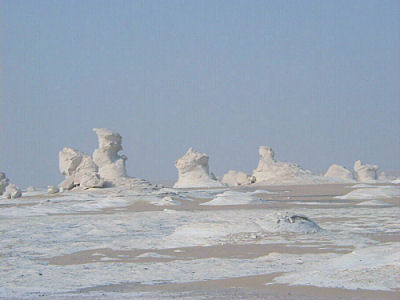The white desert of Farafra Oasis is known for its outstanding beauty and unique landscape., white rocks are beautifully sculpted by wind and sand into variable shapes, giving the spectator the impression of walking through a spectacular outdoor gallery.It is a haven for geologists, ecilogists, artists and naturalists alike.The landscape appears almost lunar because erosion by wind has for so long exceeded erosion by water,The dominating white color of chalk intensifies the lunar impressionThe white desert encompasses an area of about 5,800 km, and is relatively accessible from the asphalt road between Farafra Oasis and Bahariya Oasis which actually passes through this immensely beautiful area.The ground is strewn with hundreds of pieces of iron pyrites, which have developed into fascinating symmetrical shapes.Also, fossils of different marine shells and animals in the area have been blackened by this mineral.Acacia nilotica (sunt) tree is native to the Nile vally and Delta.It is also bountiful in the oases of Egypt where loamy soil and constant water sources are abundant.Its existence amidst the aridity of the White desert is a phenomenon that needs further investagation.The age of these huge old trees could provide a clue to a relict status of past wetter years.The tree’s canopy provides much appreciated shade in the desert, and branches and twigs are a perfect perch for the Desert Wheatear Oenanthe deserti, from where the birds actively chase after flies.The area is known to be a refuge for the Dorcas GazelleGazella dorcas dorcas which is currently threatened due to excessive hunting .One mysterious form of life is the lichen found under superficial layers of chalk, a very subtle and delicate form of life.Moving towards Bahariya Oasis , the black color gradually dominates the landscape until we reach an area known as the Black Desert.Numerous small hills scatter the vast landscape, most of which are composed of ferruginous sandstone rocks,formed in the Oligocene epoch 30 million years ago.Iron and manganese are responsible for the deep black color of those rocks.Underlying these rocks is white sandstone that was formed in a much earlier time, namely in the Cenomanian age 100 million years ago.In certain area, the two layer are exposed, and the stark difference of the two layers is quite beautiful.The prevalent monochromatic landscape enhances the deep silence and vibrant simplicity of these two outstanding areas of the Western Desert.
วันเสาร์ที่ 28 กรกฎาคม พ.ศ. 2555
White desert
สมัครสมาชิก:
ส่งความคิดเห็น (Atom)

ไม่มีความคิดเห็น:
แสดงความคิดเห็น